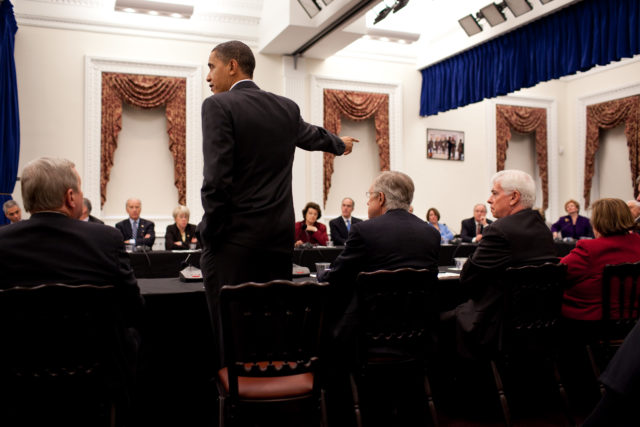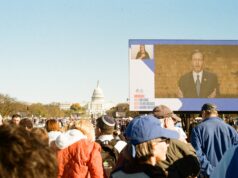
The Affordable Care Act employs two approaches to reduce the costs of health insurance. Section 1401 of the ACA directly provides subsidies to consumers to reduce the cost of policies. Section 1402 reduces certain “cost sharing” fees that insurance companies charge customers, such as deductibles and co-pays. Congress approached these sections differently. The legislative branch funded Section 1401 through what is known as a permanent appropriation, to ensure that the subsidies will always flow. Congress, however, did not create an appropriation for Section 1402 in the ACA. Each year it would require a new line item in the budget. Recognizing that Congress did not provide funding for Section 1402, the Obama administration requested a budget of $1.4 billion during fiscal year 2014. Congress denied that request. In the next round of budgeting, the executive branch mysteriously did not request any funding for Section 1402.
A lawyer on the Ways & Means Committee compared the Administration’s different budget requests for the ACA. In the later budget, he noticed the oddity that the request for Section 1402 funding was now noticeably absent. The Executive Branch seldom asks for less money, so this raised a red flag. The lawyers in the House asked what gives, and then they figured it out: After Congress denied the funding for Section 1402, the Obama administration decided to pay the insurance companies anyway. The House deemed this spending illegal. Article I of the Constitution provides that “no Money shall be drawn from the Treasury, but in Consequence of Appropriations made by Law.” No appropriation, no money. In Federalist No. 58, James Madison wrote that “this power over the purse may, in fact, be regarded as the most complete and effectual weapon” of Congress to check the executive branch.
On June 25, 2014, Speaker Boehner circulated a memorandum to the House GOP caucus. The Ohioan wrote that “for the integrity of our laws and the sake of our country’s future, the House must act now” to stop the President’s illegal executive actions. In July, Boehner would bring legislation to the floor to authorize the House General Counsel “to file suit in the coming weeks in an effort to compel the president to follow his oath of office and faithfully execute the laws of our country.” On July 30, the House voted along straight party lines – 225 to 201 – to authorize the litigation. (One Republican voted nay.)
Suing the Executive Branch
The biggest critic of this plan was President Obama. During a speech in Kansas City, Obama mocked the proposed lawsuit. He warned the crowd that Congress planned “to sue me for doing my job.” The audience booed. The President continued, “They have announced that they’re going to sue me for taking executive actions to help people.” He dismissed the litigation as a “political stunt,” as this vote is not actually working to “help you.” President Obama issued an ultimatum to Republicans. “Middle-class families can’t wait for Republicans in Congress to do stuff. So sue me.” They did.
In the lawsuit filed in November 2014, the House alleged that the Obama administration was spending funds that were never appropriated, thereby clipping Congress’s power of the purse. The case was assigned to U.S. District Court Judge Rosemary M. Collyer. The Justice Department’s first line of defense was that the House of Representatives was not injured by the payments, so it could not sue. In legal terms, the government argued that the House lacked “standing” to sue. No court had ever before held that the House of Representatives, as a body, could sue the executive branch for alleged violations of the appropriations clause of Article I. These expenditures, the Justice Department argued, did not inflict an injury on the House, so there was no standing.
However, as Judge Collyer observed, no court had ever held that the House of Representatives could not bring suit. “There is no authority that answers the question” on either side of the case, she noted. The most relevant precedent was Raines v. Byrd. The Supreme Court’s 1997 decision found that individual members of Congress could not challenge the constitutionality of the Line Item Veto Act. In Raines, Justice John Paul Stevens “attach[ed] some importance to the fact that appellees have not been authorized to represent their respective Houses of Congress in this action, and indeed both Houses actively oppose[d] their suit.” That “the plaintiff here is the House of Representatives,” Judge Collyer wrote, “distinguishes this case” from Raines. The unprecedented nature of the case left open the question of whether the House should have standing.
In September 2015, Judge Collyer ruled in favor of the House, based on what she referred to as a “non-appropriation” theory of standing. For generalized political grievances – such as over the interpretation of a statute – the court found that the House would lack standing. However, when the House asserts that the executive branch is spending money that the legislative branch had never appropriated, Collyer determined, the President has inflicted a constitutional injury on the power of the purse. If Congress “specifically denies funding and the Executive simply finds money elsewhere without consequence,” Judge Collyer wrote, then the Legislature “cannot fulfill its constitutional role.” Disregarding Congress’s power over the purse, she concluded, “inflict[s] a concrete, particular harm” that gives the House standing to sue.
Interlocutory Appeal
After the court denied the government’s motion to dismiss for a lack of standing, the Justice Department requested an interlocutory appeal. Through this procedure, the government wanted to immediately appeal the district court’s decision finding that the House had standing. The government did not want the district court to proceed to determine whether in fact the Section 1402 payments were illegal. In a move that surprised many experts, Judge Collyer denied the request for an interlocutory appeal. She announced that she could resolve the entire case “in a matter of months – likely before an interlocutory appeal could even be decided.” Collyer reasoned that by moving forward, the parties would be able to appeal both the standing issue, as well as the constitutional issue, in one case. Of course, the government would much rather win on standing, so they would not have had to defend what by all accounts appeared to be spending money without an appropriation. Judge Collyer’s denial of the interlocutory appeal shifted that burden to the Justice Department.
During an earlier hearing on standing, Judge Collyer expressed her frustration with the government’s unwillingness to defend its actions. She chided the Justice Department lawyer, “You can’t just shake your head and say no, no, I don’t have to answer that question.” When he bobbed and weaved, Collyer charged, “This is the problem I have with your brief: It’s not direct. It’s just not direct. You have to address the argument that [the House] makes and you haven’t.”
The Judge Rules
Once the court found standing, the Obama administration was required to defend its spending – and it did not go well. In May 2016, Judge Collyer issued her second decision in the case, ruling that the executive branch had illegally spent billions of dollars under Section 1402, in violation of the Constitution’s appropriations clause. The Justice Department offered three primary defenses. First, the government explained that Section 1401’s permanent appropriation could be read to also fund Section 1402 – even though there was absolutely no reference to Section 1402. Judge Collyer held that the government’s textualist argument “is a most curious and convoluted argument,” she wrote, “whose mother was undoubtedly necessity.” In other words, the creative lawyers at the Justice Department made a textualist argument because they had to say something in court.
Second, the government argued that the appropriation from Section 1401 can be understood to also cover Section 1402, because the two policies are “economically and programmatically integrated.” That is, the two provisions worked in tandem to ensure premiums under the ACA remained affordable. The court disagreed, finding that “an appropriation must be expressly stated; it cannot be inferred or implied.” Congress does not “squeeze the elephant of Section 1402 reimbursements into the mousehole of Section 1401.” Billions of dollars in spending are not left to implication. Even assuming the two policies are connected, this argument does not work, the court concluded.
Third, HHS warned that blocking payments to insurance companies would “yield absurd economic, fiscal, and healthcare-policy results.” Judge Collyer dispatched this argument, finding that the “results predicted by the [government] flow not from the ACA,” or the court’s interpretation of the law, “but from Congress’ subsequent refusal to appropriate money.” If Congress does not want the government to pay insurance companies for losses suffered because of the ACA, the court concluded, “that is Congress’s prerogative; the Court cannot override it by rewriting” the ACA. Judge Collyer ruled that paying the Section 1402 subsidies based on the 1401 appropriation “violates the Constitution. Congress is the only source for such an appropriation, and no public money can be spent without one.”
Hours after Judge Collyer’s decision, White House Press Secretary Josh Earnest referred to the case as an “unprecedented… political fight in the court system.” Never before, he said, has Congress “been permitted to sue the executive branch over a disagreement about how to interpret a statute.” He noted that Republicans have “been losing this fight for six years. And they’ll lose it again.” House Speaker Paul Ryan, who had replaced John Boehner in October 2015, praised the decision. “The court ruled that the administration overreached by spending taxpayer money without approval from the people’s representatives,” he said. “Here, the executive branch is being held accountable to we the people.” Boehner, enjoying his retirement, felt vindicated. “The president of the United States is not a king or a monarch, with the ability to single-handedly create or change the laws of our country.”
Conservatives have long advocated for a rigorous standing doctrine as a means to prevent “activist” courts from interfering with the democratic process. In 1983, then-Judge Antonin Scalia viewed standing as “a crucial and inseparable element of the separation of powers.” He wrote that making it harder for plaintiffs to bring constitutional challenges in federal court would reduce the “overjudicialization of the processes of self-governance.” The late justice’s approach to standing is sound in theory, but risky in fact, for it presumes the executive’s faithful execution of the law. In recent years, rather than protecting the separation of powers, the standing doctrine has served to insulate presidents who engage in highly questionable executive actions. Cramped standing doctrines allow abuses of presidential power to continue without any scrutiny. Government lawyers can simply walk into court, and literally shake their heads no.
If the President could spend money without an appropriation, Judge Collyer observed, our “constitutional structure would collapse, and the role of the House would be meaningless.” Critically, a House lawyer told me, “Congress can’t very well use its power of the purse as an alternative to judicial relief in such a case because it’s the purse power that’s been taken.” This long train of abuses shines a light on President Obama’s unprecedented use of executive power to rewrite the Affordable Care Act, and warrants a reconsideration of the bounds of the standing doctrine in separation of powers cases.





